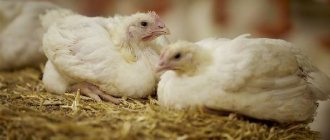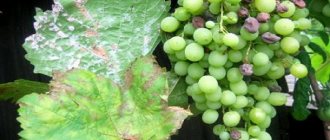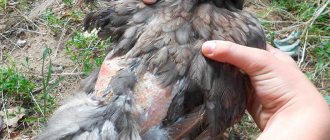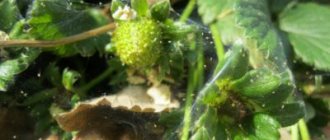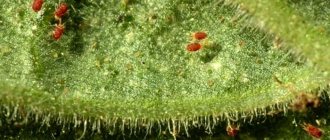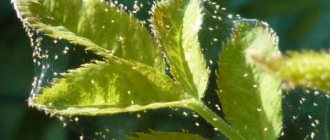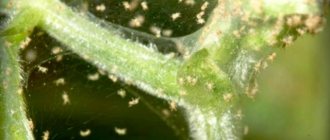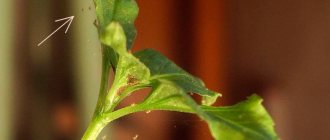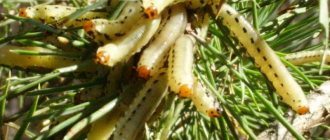Have you noticed that there are swellings (blisters) on the leaves of your grapes, and a white coating on the back side? Most likely, these are symptoms of grape infestation by one nasty pest.
Just do not confuse it with grape mildew (downy mildew) or phylloxera.
Next, you will learn how to deal with mites on grapes (especially grape itch), when and what preparations are best to use for treatment.
Detailed description of spider mites on grapes
Spider mites on grapes: photo of the pest
Spider mites belong to the arachnid family. In their size, they are very small, their body can reach a length of half a millimeter. They can be yellowish or reddish. They live mainly on the back side of the leaf blade, weaving their own small web. A vineyard can be immediately attacked by hordes of this insect pest if there are comfortable conditions for their development and reproduction.
Spider mite development cycle
There are several stages. After laying, eggs are formed. The egg hatches into a larva, which after about two or three years transforms into an adult insect. Four to seven generations can be bred in one season. This is affected by weather conditions.
Activity in spring
In the spring, fruit mite larvae begin to appear. You can see them on the leaf blades, in the form of small red dots. A simple spider mite that lays its eggs on weeds. When the larvae hatch, they independently move onto the grape plants.
The answer to the most popular question: is it possible to pick off affected leaves?
Obviously, the loss of leaves weakens the bush, in other words, by tearing off most of the leaves you will simply deprive the plant of nutrition. Therefore, at the early stage of the growing season (when there are few leaves), this is out of the question.
Accordingly, you can pick off leaves only in case of mild damage , when there are only a few such leaves (with swellings) and most are healthy.
If the damage is severe, especially since there are still few leaves, then only spraying with acaricidal agents will help you.
Well, now you know what preparations to use to treat grapes against mites. We hope that from now on your grapes will be less affected by pests and sick.
Video: grape felt mite (itching)
Types of spider mites
There are several types of mites that can infect grapevines.
The first type is the hornbeam spider mite.
This species bites through a leaf plate and then sucks out the nutritious juice from it. And it is because of this that the plant’s foliage becomes dehydrated, deprived of nutrients, dries out and falls off.
The second type is the red fruit mite.
He weaves a very fine web. It spends the winter in a kind of cocoon, which can be seen on a wooden surface. Looks like reddish growths. In summer, the female lays eggs on the lower part of the leaf blade.
The third type is the common spider mite, or grape itch.
Begins laying eggs during the growing season. It spends its winter in the bark of a grape tree or in fallen leaves. One female can lay seventy to one hundred and fifty eggs.
What kind of pest is this?
The grape mite belongs to the class of arachnids, the superfamily of four-legged mites. It has the popular names itching, felt mite, spider mite, and multiplies quickly, although it does not live long.
The parasite can only be examined under a microscope. Its presence will be visible by some signs, although at first it can be confused with mildew:
- Curly leaves with burgundy tubercles.
- Young leaves are smaller.
- Starting in mid-summer, the green mass becomes gray-white.
- Yellowing or formation of necrotic spots on the leaves.
- Young shoots are stunted in growth and dry out.
A careful inspection should be carried out along the leaf veins on the inside and outside; these places are most attractive to the pest.
If females overwinter under the bark of grapes, in cracks or buds, then in the spring they begin to show their activity at a temperature of 5-10 ° C. Throughout the winter period, females and males adapt to survival without leaving offspring - such individuals are called “deutogynous.”
With the arrival of spring-summer, females lay inseminated and uninseminated eggs, which go through 4 stages of the life cycle and are called “protogynous”, actively reproducing throughout the warm season.
This type of parasite is most often transmitted with new grapes, during grafting, or carried by insects and wind. Mites climb into the bark for the winter on varieties with early ripening, and on others - into the buds.
How to understand that spider mites have attacked grapes
Spider mites on grapes: photo
- Lightened, disproportionate spots form on the leaf blades.
- A brown dot appears at the core of the spot. This occurs due to the fact that those cells that were damaged by the pest begin to dry out.
- As soon as pests appear on the crop, the foliage stops growing, that is, it remains small.
- The shoots also stop growing and appearing.
- The foliage begins to curl up, change its color, dry out and fall off.
- You can also notice small cobwebs on the back of the leaf blade. As it develops, a web will form on several leaves as well as stems.
- When eggs are laid, growths of a red-orange hue will be visible along the perimeter of the veins. These are eggs. Over time, a larva, that is, a nymph, hatches from them. When she sheds about two or three times, she will already be an adult.
Spider mites on grapes: video about the pest
Spider mites can appear on grapes of any age. It will attack crops in accordance with their varietal, soil structure, condition of the crop itself and its nutrition. Also, the place where the grapes grow plays a big role. In dry and warm weather, spider mites will spread most actively. His attack threatens that the grapes will develop worse and become weak. It can appear through a person or animal, which can bring it on their soles or paws, the tick itself, or its egg. The eggs remain viable for five years.
What does grape itch look like?
It is almost impossible to see the itch well with the naked eye, since the grape felt mite is very small in size. Only with multiple magnification can you see that the tick’s body looks like a light or yellowish worm larva. The length of the female corresponds to 0.16-0.20 mm, and the male – 0.14 mm. The insect's abdomen has numerous small bristles at the front and rings with spines at the back and middle of the body.
A female tick can produce up to 7-12 generations of parasites during the year. Itch eggs have a transparent structure, oval shape and their size is 0.038 x 0.058 mm. You can find the eggs of the insect, as well as the insect itself, under swollen buds and under a white coating on the back of the affected leaves.
Spider mites on grapes: control methods
Spider mites on grapes: photo
About biological control measures.
Predatory insects, namely entomophagous mites, can help in the fight against spider mites on grapes. Insect predators can be purchased at specialized garden stores.
In the fight against spider mites on grapes, it is recommended to purchase such predators as:
- Phytoseiulus;
- Amblyseius californica;
- Amblyseius Mackenzie;
- Metaseiulus occidentalis.
These species will feed on laid eggs, as well as insect larvae. Some species can also devour adult specimens. These predatory species are quite voracious and also reproduce quickly. One female can eat up to twenty to twenty-five pests in just twenty-four hours, and also does not forget to lay eggs, approximately from two to six pieces. These predators live approximately eighteen to twenty-five days.
But since they lay eggs during their life, from which larvae then hatch, these larvae also continue to eat pests. The productivity of these organisms is often compared with chemicals from the acaricidal group. This comparison occurs due to the fact that these predators deal with pests quite quickly. Warmth and moderate air humidity are considered the most comfortable conditions for life. They can also be replaced by some insect, like the lacewing. It is recommended to resort to their help when your crops grow in an enclosed space. But if the plantation is large, it would be wiser to resort to chemicals.
Control using plant crops
These measures, rather preventive, are also deterrent. There are some plants whose smell is not liked by spider mites. Such phytoncidal crops are: onions and garlic. They can be planted between beds and holes.
Preventive measures.
In the fight against insect pests, preventive measures are very important.
- If the plant is not very badly affected, then you can use traditional countermeasures.
- If the plant is severely affected, then you should seek help from chemicals.
These measures must be joint and permanent. They will help protect the crop from various insect pests. But if agricultural technology is incorrect and care is insufficient, then the yield can be reduced to fifty percent of the total mass. If the plant is already sick, then it is not preventive measures that are needed, but correct and timely treatment.
There are several recommendations for preventative measures.
- It is very important to follow all agrotechnical rules that are necessary for the active growth and development of the bush.
- It is necessary to conduct a timely inspection of the foliage part, as well as the entire plant, for the presence of insect pests.
- When new seedlings appear, they also need to be carefully examined and quarantined in order to identify the possible presence of parasites.
- Based on the fact that this pest does not like a high percentage of air humidity, it is necessary to spray the crop in a timely manner.
- It is necessary to develop a suitable watering regime, as well as timely feed and fertilize the plants.
- You need to weed your garden in a timely manner. That is, to destroy various weed crops. There are those types of mites that hatch specifically on weeds and then independently move to fruit and berry plants.
- It is necessary to tie up the grapes in time. That is, you need to ensure that its shoots do not touch the ground. This can be fraught not only with damage to insect pests, but also with fungal infections.
- In the autumn, after harvesting, you need to remove all fallen leaves, as well as cut off the dried parts. This is necessary because some types of ticks spend their winter in fallen leaves.
- With the onset of autumn, the soil needs to be dug up. Those insects and egg-laying eggs that spend the winter in the soil, once outside, will die from the cold.
- If you notice the appearance of this insect pest, immediately spray your crop with a soap solution. This, of course, will not kill them all, but it will significantly reduce their number. Then proceed with the necessary processing measures.
Spider mites on grapes: fighting with folk recipes
Spider mites on grapes: photo
A large percentage of garden lovers do not like to use chemicals to control insect pests. And they give preference to folk and organic methods.
Fight spider mites with horseradish infusion.
To do this, you need to chop the foliage, as well as the shoots, and then fill the bucket to thirty percent, and fill the rest with water. Mix all this thoroughly and let it brew for sixty minutes. Approximately the same spirit can be produced from the root system of horseradish. But then you need to take a couple of times less raw materials.
Fight spider mites with dandelion infusion.
In this case, you need to take thirty to forty grams of the dandelion root system, chop it and add a liter of clean water at room temperature. Then let it sit for several hours and you can start spraying.
How to use folk infusions.
There are several tips and their explanation. You need to treat a plant with an infusion right away, because the longer it sits idle, the more it will lose its beneficial properties. You can also add small shavings of laundry or baby soap - this will add stickiness. By adding soap, the infusion will last a little longer on the leaf plates and will also extend its productivity.
Many people believe that traditional methods are the safest, but others say that protective clothing should be used. This is due to the fact that these plants, which are used to control insects, contain a certain amount of toxic components. That is why protective equipment still needs to be used. And also after treatment, take a shower and wash your hands thoroughly.
Fight with chemicals.
If the plant is severely affected, then there is a danger of losing the entire harvest. In the event of a massive spider mite infestation, preventative and traditional methods will no longer help. You need to resort to chemicals. If you do not start processing and do not drive away insect pests from your plantations, then after twenty-four to thirty-six months, there may be nothing left of it.
The most effective and well-known chemicals for controlling insect pests.
The chemical preparation is acarin or agravertine.
This species belongs to the contact-intestinal group; it can affect a large number of insect pests. It will not pollute the environment. When destroyed, it falls directly into the ground. How to make: one or two milliliters of the product, you need to dilute it in one liter of clean water at room temperature. It is recommended to treat plants at a temperature of plus eighteen degrees. It lasts for approximately four to eight hours. The prepared solution cannot be stored; it must be used immediately.
The chemical is Actellik.
This drug has a wide range of effects. It acts contact, fumigate and systemically. To make it you need: dilute two milliliters of the product in one liter of clean water at room temperature. You need to spray immediately after you have prepared the solution. It cannot be stored. It should be remembered that it is harmful to all living organisms, because it is in the second class of danger. Read more about Actellik here.
The chemical is Apollo.
This is a contact acaricidal agent. It can destroy the larvae and eggs of pests. It also sterilizes adult specimens, but does not kill them. It can be combined with various chemicals. Will not harm beneficial insects and pollinating insects. To make the solution you need: dilute one teaspoon of the drug in ten liters of clean water at room temperature. It should be sprayed using a fine spray.
The chemical is demitane.
This is a contact agent and is recommended to be used at a time when tick colonies are still forming. It will be productive at any stage of tick development. It lasts for a very long time, about forty-five to sixty days. The percentage of toxicity to beneficial insects and pollinating insects is quite low. Plants only need to be treated once; if there are more treatments, insect pests can develop immunity. This remedy can be used in turn with other acaricidal drugs.
Chemical drug - karate.
The drug has a fairly wide range of effects. It acts intestinally, contactally and fumigately. What should the solution be: for this, you need two tenths of a milliliter, diluted in one liter of clean water at room temperature. Treatment should be carried out twice with a break of ten to fifteen days. Can be used in any weather conditions. It is not washed off by rain for sixty minutes. It should be remembered that it is quite harmful to living beings. It is in the second hazard class.
Less known but effective chemical control agents.
This list includes drugs such as: 1) bicol; 2) bitoxybacillin; 3) neoron; 4) Nissan; 5) sunmite; 6) fitoverm and many others. All these drugs have a wide spectrum of effects. When choosing a drug, it is better to consult with the seller in a specialized garden store. But against insect pests, you need to choose only acaricidal agents, because they will help with insect pests.
How to spray.
When spraying, you need to pay attention not only to the foliage, vine and plant itself, but also to the soil and the tree trunk of the plant. After all, it is there that clutches of eggs may be located. It is also recommended to add small shavings of green, laundry, or baby soap to the solution before processing. This will ensure better adhesion, and the solution will last much longer.
Why is itching dangerous for the grape harvest?
It is known that grape itch from the leaves is capable of moving to the young ovary, shoots and flowers of grapes. Consequently, other parts of the vine are also affected. If the affected areas of the grapes are not treated in a timely manner, this can lead to their death and a decrease in overall yield.
In addition, this type of mite is capable of transmitting viruses dangerous to grapes, which negatively affect the ripening of fruits, the condition of the root system, leaves, which can ultimately lead to the death of the grapevine.
Is autumn digging necessary to prevent spider mites on grapes?
Many people ask this question because they believe that the root system can be damaged and die when cold weather sets in. But you still need to dig, because it helps destroy laid insect eggs. When digging, they will end up in the open air, or too close to it, which will destroy them when frost sets in. You should also remember that they hide in the bark of the plant, and also in fallen leaves. To protect the root system, you can mulch the tree trunk circle.
Prevention of infection
Prevention is the best way to protect your vineyard from pest attacks.
Preventive measures that can be taken to prevent mites from infecting grape bushes:
- tie the vine and prevent it from coming into contact with the ground;
- regularly inspect the vineyard in order to identify insects in time;
- inspect and process purchased seedlings, arrange for them to be quarantined;
- Spray the bushes regularly, because the parasite prefers dry conditions;
- fertilize plants to increase their immunity and resistance to diseases and pests;
- destroy weeds;
- in the fall, burn fallen leaves, garbage and crop residues;
- remove lower leaves from bushes;
- spray in the spring with insecticides or compositions prepared according to folk recipes.
Important! If, when any type of mite is detected, the necessary measures to eliminate it are not taken in the near future, you can lose up to 50% of the entire harvest, and after a few years the entire vineyard.
Experienced winegrowers recommend using an integrated approach - if a pest appears, using agrotechnical methods and chemical or folk preparations. Also remember that taking preventative measures is easier than dealing with the scourge later.
Purpose and scope
Actellik is an insecticide used in agriculture and on the personal plots of ordinary citizens. Initially intended only for the disinfection of grain storage facilities and warehouses. Later, due to its effectiveness, it began to be used in gardens and vegetable gardens to control pests.
Interestingly, the agricultural company Singenta produces the drug only in canisters. The insecticide appeared in small packaging later from other companies.
What pests does it help with:
- whitefly;
- Colorado beetle;
- false scale insects and scale insects;
- sawflies;
- kidney and spider mites;
- weevils;
- thrips;
- phylloxera;
- codling moth;
- scale insects;
- leaf roller;
- bedbugs.
Actellik is active against all forms at different stages of insect development (larvae, caterpillars, pupae, adults), excluding the egg phase.
It is used on fruit trees, berry bushes: raspberries, gooseberries, currants, serviceberry, honeysuckle, hawthorn, ornamental plants (roses, orchids). It showed good results when processing conifers (arborvitae, pine), flower and vegetable crops, strawberry and grape plantations.
In agriculture, the drug is used for disinfestation of storage facilities (before they are filled) and warehouses. The grain stored for storage is also processed, and there is no need to dry it after spraying and ventilate the barns.
Advantages and disadvantages
As soon as Actellik appeared in ampoule form, summer residents adopted it. The reason is the quick achievement of results, as well as a wide range of pests destroyed. In addition, the insectoacaricide has other advantages:
- complex effect on insects (intestinal, contact, fumigant);
- long period of action;
- Ease of use;
- extermination of insects and ticks (insectoacaricide);
- consistency;
- Possibility of use for exterminating pests in hard-to-reach places;
- absence of resistance (addiction) of insects to the drug, subject to strict adherence to recommendations and alternation of products.
The use of "Aktellik" prevents the reappearance of pests, while it is used for open ground, indoors, greenhouses, greenhouses.
Flaws:
- a toxic product, therefore it is necessary to strictly adhere to the standards;
- high price;
- effectiveness only when used in a certain temperature range - +15 ºC…+25 ºC.
There are many fakes on sale, so it is important to carefully study the label when purchasing only original Singenta products (see photo of the company logo).
Agrotechnical methods for removing parasites
If a harmful spider mite appears on varietal grapes, then experienced gardeners will tell you how to deal with it correctly
They note that it is important to process the vines locally and in a timely manner. Agrotechnical techniques are simultaneous prevention of the occurrence of parasites
They are used during any grape growing season:
- vine staking, which reduces the likelihood of insect access;
- mandatory digging of soil in autumn or spring;
- removal and subsequent burning of damaged bark, leaves, branches of a grape bush.
Many of the winegrowers who have struggled with the parasite advise drawing up a crop processing calendar or using effective drugs.
Precautionary measures
- It is undesirable to stay in the room where plants were treated for a long time, since the drug has a high vapor pressure.
- You cannot prepare the working solution in food containers.
- Children and animals should not be present when plants are treated with Actellik.
- It is forbidden to drink, eat and smoke while working with the drug.
- It is necessary to use protective equipment: respirator, goggles, gloves, special clothing.
It is not known exactly how long the half-life of the active substance takes: according to some sources, the process lasts 11-15 weeks, according to others – no more than 2-3 days. Therefore, precautions are so important both during the procedure and after it. After completing the work, you need to wash your hands and face with soap, rinse your mouth, and also treat the surfaces with which the product came into contact with soap and water: shelves, glass, window sill. Protective clothing, goggles and masks should also be thoroughly washed and washed.
Maliciousness
The felt grape mite is capable of multiplying very quickly and, despite its relatively short life, causes serious damage to grape plantings. Quickly spreading throughout the infected plant, the parasites disrupt the growth of leaves and affect their color - they acquire a reddish-brown tint. This condition is not normal for plants, and therefore their photosynthesis is disrupted, causing the leaves to gradually dry out and fall off. If the grape itch has reached the inflorescences, they will also soon change their natural color to red and subsequently die off.
Thus, if the felt mite is not stopped in time, then after some time the grapes will lose all their green mass, then the fruits and bush will die. However, it is very important here not to confuse this parasite with mildew, a fungal disease of grapes. Recognizing the pest is quite simple - you need to run your finger over the felt coating, and if it remains in place, then you are dealing with a grape mite.
Processing regulations
Application depends on the purpose of treatment, but in any case, calculate the amount of solution and observe the dosage of the drug.
Treatment method: spraying onto parts of plants where pests are found. The packages must contain instructions for use, so there are no difficulties with dosages or consumption rates.
On a note! Fine-dispersed sprayers that deliver the working composition in small drops are recommended.
| Culture | Dosage | Consumption | Features of treatments |
| Cabbage, carrots, beets | 2 ml per 700 ml water | 1 liter of working composition per 10 m² | Treatment at least one month before harvest |
| Tomatoes, peppers, eggplants, cucumbers (indoors) | 2 ml per 700 ml water | 1 l per 10 m² | Double treatment, interval – 8-10 days |
| Tomatoes, peppers, eggplants, cucumbers (open ground) | 2 ml per 700 ml water | 2 liters of working solution per 10 m² | Double treatment, interval - 8-10 days |
| Fruit trees (apple, pear, peach, apricot) | 2 ml per 2 liters of water | 2-5 l per mature tree | If there are a large number of insects, the dosage is increased to 4 ml of the drug per 2 liters of water |
| Cherry | 2 ml per 2 liters of water | 2-3 l per plant | |
| Berries (gooseberries, currants, raspberries) | 2 ml per 1.5 liters of water | 1.5 l per 10 m² | Double spraying, interval - a week |
The sheet plates are completely treated, preventing the solution from flowing into the ground. The approximate duration of the drug is from 7 to 14 days.
For subsequent treatments, it is recommended to use insecticides of other classes. This allows you to avoid insects becoming accustomed to the drug.
To treat warehouses or storage facilities, dilute 16 ml of the drug in 1 liter of water. Approximately 30-50 ml of working composition is consumed per 1 m². Spray cellars and basements 25-30 days before storing vegetables or fruits. The effect of the product is 7-12 months.
Compatibility with other tools
Actellik insecticide can be used as part of tank mixtures. It is compatible with a wide variety of drugs (fungicides, pesticides), with the exception of alkaline and acidic compounds, dusts.
On a note! There is no compatibility with drugs containing copper and calcium. Do not use with growth stimulants “Zircon” or “Epin”.
Treatments with Actellik and the use of biological protection agents (with encarsia) are possible.
Description of the drug and mechanism of action
The insectoacaricide is based on the substance pirimiphos-methyl, which belongs to the chemical class of organophosphorus compounds. In its pure form it is a straw-colored liquid with low volatility. In terms of danger, preparations based on pirimiphos-methyl belong to classes II and III for humans, and to class I for bees.
The mechanism of action is to block a special enzyme - acetylcholinesterase. The organic compound accumulates in the tissues of the nervous system, which leads to a malfunction of various organs and subsequently to poisoning of the insect.
Types of impact:
- contact - the active substance penetrates the body and affects the nervous system of insects;
- intestinal - poisoning occurs when the poison enters the digestive system of the pest.
In addition to the contact-intestinal effect, the product has a translaminar and fumigant effect. Pests die when vapors of the drug enter the respiratory system. Thanks to the systemic action, high results are achieved in the fight against dangerous pests. In essence, using an insecticide can get rid of insects and, in many cases, literally save the crop.
